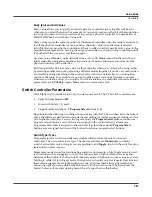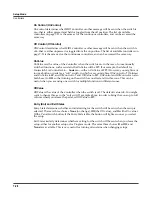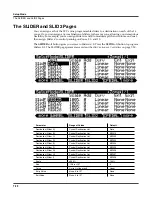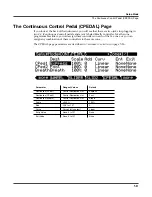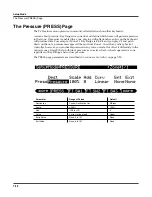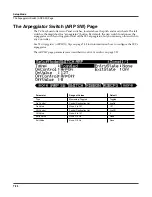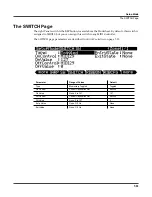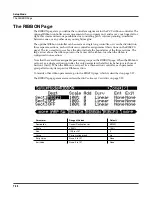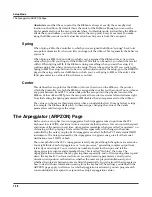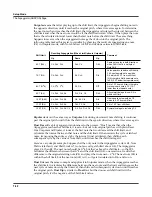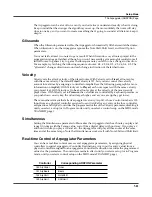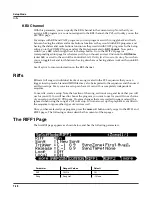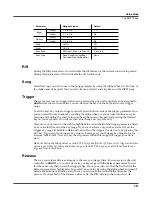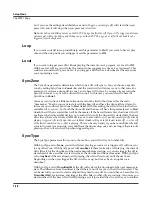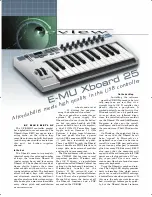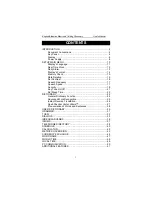
7-38
Setup Mode
The Arpeggiator (ARPZON) Page
Absolute
means that the zero point for the Ribbon is always at exactly the same physical
location on the ribbon. By default this is the center of the Ribbon, although you can use the
Center parameter to put the zero point elsewhere. In Absolute mode, just touching the Ribbon
affects the sound (unless you touch it at exactly the zero point). Every movement you make
along the Ribbon sends control values based on how far you are from the zero point.
Spring
When Spring is
On
, the Controller to which you’ve assigned the Ribbon “springs” back to its
zero point automatically when you lift your finger off the ribbon. This is generally the behavior
you want.
When Spring is
Off
, the Controller to which you’ve assigned the Ribbon sticks at its current
value when you lift your finger off the Ribbon. While this can be useful, you should be careful
with it. When Spring is
Off
, if the Ribbon is doing something when you exit the setup, it’ll
continue doing that when you return to the setup. This can be good or bad. If you want to set
Spring to
Off
in a setup, but want to be sure of the initial sound of the setup, go to the RIBBON
page in the setup, and for each Ribbon for which you’ve set Spring to
Off
, set the entry value
(Ent) parameter to a value of
0
(or whatever you like).
Center
This defines the zero point for the Ribbon (or for each section on the Ribbon)—the point at
which the Controller to which the Ribbon is assigned has no effect on the sound. You can choose
any point between
0
and
127
. A value of
64
puts the zero point in the physical center of the
Ribbon. Values of
0
and
127
place the zero point at the section’s extreme left and extreme right.
Note that setting the Spring parameter to
Off
disables the Center parameter for that ribbon.
The value you choose for this parameter can have considerable effect. In many factory setups,
for example, the Ribbon affects pitch. In these setups, changing the value of the Center
parameter would transpose the setup.
The Arpeggiator (ARPZON) Page
Each zone in a setup has its own Arpeggiator. Each Arpeggiator takes input from the PC3
keyboard (or via MIDI) and turns it into a constant rhythmic pattern. You can control the speed
and nature of the pattern in real time. Arpeggiators resembles what were called “sequencers” on
old analog synths—playing a finite series of notes repeatedly, with changes in the series
controlled by the notes you play. Each Arpeggiator can affect both the PC3 and external MIDI
instruments. The notes produced by the Arpeggiator in a given zone go to all of that zone’s
destinations: local, MIDI, or both.
The concept behind the PC3’s Arpeggiators is fairly simple, although the options are extensive.
You might think of each Arpeggiator as a “note processor,” generating complex output from
relatively modest input. You can select any number of notes for the input, and tell the
Arpeggiator to recognize and remember them. This is called “latching” the notes. The
Arpeggiator then processes them by playing them repeatedly, and/or transposing them up and
down the keyboard. You have control over several processing parameters: velocity, order,
duration, transposition, orchestration, whether the notes are played simultaneously, and
whether the intervals between notes are filled chromatically. You can also tell the Arpeggiator
how to deal with new information coming from the keyboard. The settings you define on the
ARPZON page apply to all zones for which arpeggiation is activated; you can program each
zone individually to respond to or ignore the setup’s arpeggiation values.
Summary of Contents for PC3
Page 24: ...1 6 Introduction Options ...
Page 50: ...4 4 The Operating Modes Using the Modes ...
Page 174: ...7 54 Setup Mode The Utility Soft Buttons ...
Page 178: ...8 4 Quick Access Mode Making Your Own QA Banks ...
Page 204: ...9 26 Effects Mono Algorithms ...
Page 266: ...A 2 MIDI Implementation Chart ...
Page 308: ...Index x ...




